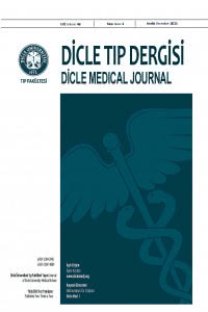Pektus Bar’lı Olguların Serum ve İdrar Örneklerinde Eser Elementlerin Değerlendirilmesi
Evaluation of Trace Elements in Serum and Urine Samples of Patients with Pectus Bar
___
- 1. Kajzer A, Kajzer W, Dzielicki J. et all. The study of physicochemical properties of stabilizing plates removed from the body after treatment of pectus excavatum. Acta of Bioengineering and Biomechanics. 2015; 17: 35-42.
- 2. Alonso Rubio JCG, Alonso MC, Clemente MA, et all. Determination of metallic traces in kidneys, livers, lungs and spleens of rats with metallic implants after a long implantation time. Journal of Materials Science:Material in Medicine; Jan 2008, Vol.19 Issue 1, 369-75.
- 3. Avino P, Capannesi G, Manigrasso M, et all. Element assessment in whole blood, serum and urine of three Italian healty subpopulatıons by INAA. Microchemical Journal, 2011, Nov 1; 99: 548-55.
- 4. Pazzaglia UE, Minoia C, Gualtieri I, et all. Metal ions in body fluids after arthroplasty. Acta Orthop. Scand. 1986 Oct; 57: 415-8.
- 5. Chassot E, Ouadedesse H, Barbotteau Y, et all. Tentavive for trace elements evalation by pixe method versus depth in soft tıssues near metallic implants. Journal of Trace and Microprobe Techniques, 2002, Vol.20: 571-80.
- 6. Graham JA, Gardner DE, Waters MD, et all. Effect of trace metals on phagocytosis by alveolar macrophages. Infection and immunity. 1975 Jun 1; 11: 1278-83.
- 7. Lopez GD. Biodeterioration and corrosion of metallic implants and prostheses. Medicina. 1993; 53: 260-74.
- 8. Krischak GD, Gebhard F, Mohr W, et all. Difference in metallic wear distribution released from commercially pure titanium compared with stainless steel plates. Arch Orthop Trauma Surg. 2004, Mar 1; 124: 104- 13.
- 9. Zhou Z, Liu X, Liu Q, et all. Evaluation of the potential cytotoxicity of metals associated with implanted biomaterials. Preparative Biochemistry & Biotechnology, 2008,Dec 23; 39: 81-91.
- 10. Fraga G. Cesar. Relevance, essentiality and toxicity of trace elements in human health. Moleculer Aspect of Medicine. 2005, Aug 1; 26; 235-44.
- 11. Michel R, Hofmann J, Löer F, et all. Trace element burdening of human tissues due to the corrosion of hip – joint prostheses made of cobalt-chromium alloys. Archives of Orthopaedic and Trauma Surgery. 1984, June 1; 103: 85-95.
- 12. Rushing GD, Goretsky MJ, Gustin T, et all. When it is not an infection: metal allergy after the Nuss procedure for repair of pectus excavatum. Journal of pediatric surgery. 2007, Jan 1; 42: 93-7.
- 13. Shah B, Cohee A, Deyerle A, et all. High rates of metal allergy amongst Nuss procedure patients dictate broader pre-operative testing. Journal of pediatric surgery. 2014 Mar 1; 49: 451-4.
- 14. Fortmann C, Göen T, Krüger M, et all. Trace metal release after minimally-invasive repair of pectus excavatum. PloS one. 2017 Oct 12; 12: e0186323.
- 15. Cundy TP, Kirby CP. Serum metal levels after minimally invasive repair of pectus excavatum. Journal of pediatric surgery. 2012 Aug 1; 47: 1506-11.
- 16. Kim YJ, Kassab F, Berven SH, et all. Serum levels of nickel and chromium after instrumented posterior spinal arthrodesis. Spine. 2005 Apr 15; 30: 923-6.
- 17. Nwashindi A, Dim EM. Adverse effects of nickel in transosseous wires and surgical implants: literature review. Nigerian journal of medicine: journal of the National Association of Resident Doctors of Nigeria. 2014; 23: 335-43.
- 18. Falagiani P et al. Systemic nickel allergy syndrome (SNAS): A review. Rev Port Immunoalergologia 2008; 16: 135-47.
- ISSN: 1300-2945
- Yayın Aralığı: 4
- Başlangıç: 1963
- Yayıncı: Cahfer GÜLOĞLU
Serkan DEĞİRMENCİOĞLU, Olçun Ümit ÜNAL, Esin OKTAY
Ocular and Systemic Safety of Mirabegron Treatment in Elderly People with Overactive Bladder
Karaciğer hidatik kist cerrahisinde dökülme ve nüks
MEDİHA TÜRKTAN, ALPER AVCI, Suat GEZER, Orhan Kemal SALİH
Bruselloz Hastalarında Asimetrik Dimetilarjinin (ADMA) Düzeylerinin Araştırılması
Muhammed SEZGİN, MERVE AYDIN TERZİOĞLU, FARUK KARAKEÇİLİ, Aytekin ÇIKMAN, Barış GÜLHAN, YUSUF KEMAL ARSLAN
Aicardi Sendromlu Kardeşler: Olgu Sunumu
Veysel KAPLANOĞLU, Hatice KAPLANOĞLU, Havva AKMAZ ÜNLÜ
Sağlık Alanında Kullanılan Kantitatif Yöntem, Stereoloji
Yavuz ORAK, Salih YILDIRIM, Rukiye MENENCİOĞLU, Ahmet ALTUN, Filiz ORAK, Cevdet DÜGER, Esra ÖZPAY, Fatih Mehmet YAZAR
Bir Üniversite Hastanesi Çocuk Psikiyatrisi Polikliniğinde Değerlendirilen Suça Sürüklenen Çocuklar
Thymoquinone induces apoptosis via targeting the Bax/BAD and Bcl-2 pathway in breast cancer cells
